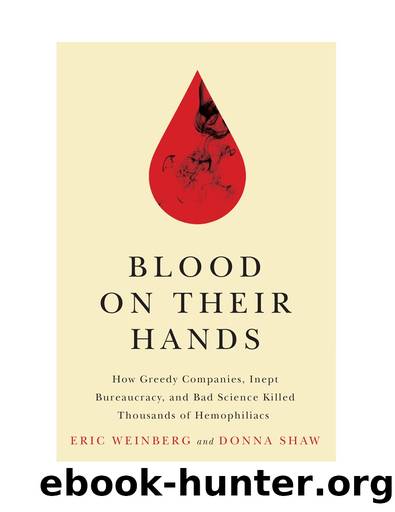Blood on Their Hands: How Greedy Companies, Inept Bureaucracy, and Bad Science Killed Thousands of Hemophiliacs by Eric Weinberg & Donna Shaw

Author:Eric Weinberg & Donna Shaw [Weinberg, Eric & Shaw, Donna]
Language: eng
Format: epub
Tags: Liability, Medical, Science, History & Theory, History, Industries, Life Sciences, Hematology, Pharmaceutical & Biotechnology, Social Science, Political Science, Corruption & Misconduct, Biology, Business & Economics, Disease & Health Issues, Aids & Hiv, Law, General
ISBN: 9780813576244
Google: 8No5DwAAQBAJ
Goodreads: 36701567
Publisher: Rutgers University Press
Published: 2017-09-15T00:00:00+00:00
13
The Trouble with Torts
Tort: n. from French for âwrong,â a civil wrong or wrongful act, whether intentional or accidental, from which injury occurs to another.
âLaw.com
The tort reform movement, long a contentious political issue in the United States, aims to sharply reduce the numbers of civil lawsuits. As described by John T. Nockleby and Shannon Curreri in a 2005 law review article:
In the 1970s insurance companies, tobacco interests, and large industry launched a political campaign attacking the American civil justice system. Unlike previous reform efforts that sought to change rules of law through case-by-case adjudication in the courts, the self-styled tort âreformâ movement pursued a much grander vision: transforming the cultural understanding of civil litigation, and especially personal injury lawsuits, by attacking the system itself. . . . Before the tort reform movement galvanized conservative politicians in the 1970s and 1980s, most nonlawyers had no idea what a âtortâ was. By the 1990s, however, the Republican Vice President of the United States could give speeches proclaiming that the tort system was broken, and that his party was prepared to fix it.1
Across the country, the reformers persuaded state after state to enact tort-reform measures, including limits on the types of civil cases that could be filed and caps on monetary damages (and thus, legal fees). In the early and mid-1990s, as the hemophilia cases were coming to trial, this movement was gaining momentum. The hemophilia advocates and their lawyers had to push back, and hard.
New Jerseyâs activists were in the vanguard. Ron Grayzel became a leader and advocate, helping to form a coalition of citizen interest groups to do battle in Trenton against the tort reformers. He asked Elena Bostick and the Hemophilia Association of New Jersey to join the coalition, and they agreed.
It was a natural fit, and a savvy move by Grayzel. HANJ was a strong organization, and no group had a greater interest in preserving its membersâ rights to sue. Grayzel and Weinberg enlisted them in a push to create an exception, or window, to the stateâs statute of limitationsâone that would briefly allow people with hemophilia and HIV to sue the drug companies even though the statute clock had run out.
In March 1994, the coalition held a dinner in New Brunswick, featuring Ralph Nader as the keynote speaker. Grayzel was master of ceremonies. Weinberg and his wife, Diane, sat a table with Bostick, Salgado, and others. The atmosphere was charged; for this audience, tort reform was an effort to portray their life-and-death struggles as frivolous and greedy.
The coalition represented the frontline troops, and Grayzel was their leader. He strode to the podium and began to address the buzzing crowd. They were with him from the start, cheering when he identified himself as HANJâs lawyer.
Grayzel exhorted them to fight. He was as animated as Weinberg had ever seen him. Then he introduced Nader, the champion of the underdogs, and the crowd roared even louder. Grayzel had become the face of the hemophilia litigation in New Jersey, and Weinberg realized that he had to accept that.
Download
This site does not store any files on its server. We only index and link to content provided by other sites. Please contact the content providers to delete copyright contents if any and email us, we'll remove relevant links or contents immediately.
Nudge - Improving Decisions about Health, Wealth, and Happiness by Thaler Sunstein(7238)
iGen by Jean M. Twenge(5158)
The Fire Next Time by James Baldwin(5015)
Adulting by Kelly Williams Brown(4230)
The Hacking of the American Mind by Robert H. Lustig(4080)
The Sports Rules Book by Human Kinetics(4072)
The Ethical Slut by Janet W. Hardy(4036)
Captivate by Vanessa Van Edwards(3721)
Mummy Knew by Lisa James(3519)
In a Sunburned Country by Bill Bryson(3361)
The Worm at the Core by Sheldon Solomon(3325)
Ants Among Elephants by Sujatha Gidla(3278)
Suicide: A Study in Sociology by Emile Durkheim(2902)
The Slow Fix: Solve Problems, Work Smarter, and Live Better In a World Addicted to Speed by Carl Honore(2837)
The 48 laws of power by Robert Greene & Joost Elffers(2800)
Humans of New York by Brandon Stanton(2683)
Handbook of Forensic Sociology and Psychology by Stephen J. Morewitz & Mark L. Goldstein(2603)
The Happy Hooker by Xaviera Hollander(2582)
The Tipping Point by Malcolm Gladwell(2553)
